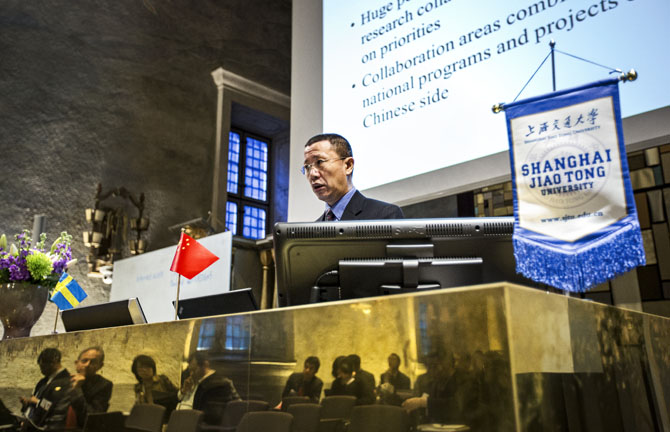
KTH and China cooperate on a large scale
Cooperation with China continues to grow at KTH Royal Institute of Technology. A series of recent exchanges included a workshop on materials and energy held for researchers from KTH and Shanghai Jiao Tong University, SJTU, before the summer break.
“There are several similarities between our universities. Identifying the common ground in research is always stimulating and produces useful information,” says Chao-yong Xie, a professor at SJTU.
Some 30 scientists from each institution participated in the workshop to identify potential collaborations, from matching research to joint applications for the EU research program, Horizon 2020. Representatives of companies such as Sandvik, Alstrom and ABB, as well as representatives of various research centres, also participated.
Börje Johansson, professor of Applied Materials Physics at KTH, noted that cooperation with China has been building for a long time:
“Development in China is so fast and furious, it is certainly gratifying that they want to have us aboard the train,” Johansson says.
KTH’s exchange with China began more than 10 years ago, and has grown along with the needs of engineering and the booming economic growth that China has seen during the same period.
“We were early out and have built up the relationship for a long time, which is a clear advantage,” says Ramon Wyss, Vice President in charge of international projects at KTH, who has been involved from the start.
Knowledge and skills exchanges take place at a number of levels. KTH has 18 highly-rated partner universities in China, with collaborations in teaching and research appointments at the central university level.
There is an intensive exchange of researchers between KTH and its Chinese partner institutions. More than 100 master's students and 50 doctoral students come to KTH from China annually; and some 20 Swedish KTH students go the other way.
In addition, there are ongoing collaborations in eight joint research centers, in areas such as materials and energy, and biomedical engineering.
“The laboratory infrastructure is now often more advanced in China, and the Chinese students have an incredible drive,” Wyss says, pointing out that the country’s research universities are fiercely competitive.
About 7 million Chinese youth take the university entrance examination every year; and some universities get more than 1,000 applications per place. Nearly a million engineers are trained every year.

Thinking big is important in engineering research in China. The world's most populous country has entirely different proportions than Sweden. How do you build a functioning public transport almost 23 million Shanghai residents, compared to the 1 million or so in Stockholm? Or a functioning traffic network when families in the growing middle class may own as many as three cars each?
“A part of the challenge for KTH researchers is to think on such a large-scale when it comes to water treatment or urban planning, or whatever it may be,” Wyss says.
The cooperation involves virtually all areas of technology, with specific emphasis on energy, transportation, life science, information and communication technology (ICT) and materials.
“In China there is a great optimism about development, and engineers are at a premium.”
As a major economic power with a huge market, China has attracted many foreign companies, including KTH’s strategic partners such as ABB, Sandvik, Ericsson and Scania.
“Cooperation with the business community in the region further develops our cooperation with China,” Wyss says, pointing to the Swedish centre at SJTU which opened last fall in order to strengthen Swedish-Chinese cooperation on several levels. Sandvik became the first member of the centre, which serves as both a meeting place and a collaboration centre for Swedish and Chinese enterprises.
The extensive collaboration between researchers from KTH and from the top Chinese universities also is demonstrated in scientific publishing.
“KTH Royal Institute of Technology is the university in Sweden that has the most joint publication with Chinese researchers,” Wyss says.
The KTH-Chinese connection is being developed further, not least with SJTU in Shanghai and Tsinghua University in Beijing, one of the world's largest technology and engineering universities.
With Tsinghua, KTH has already developed a joint campus in the virtual world. C-campus was inaugurated in 2012, enabling teachers and lecturers from both universities to meet through their avatars, or virtual personal counterparts, in an IT-based communication platform.
“For KTH, which seeks to contribute to solving the world's major challenges, the cooperation with China give us a unique opportunity to help create a more sustainable world,” Wyss says.
Jill Klackenberg